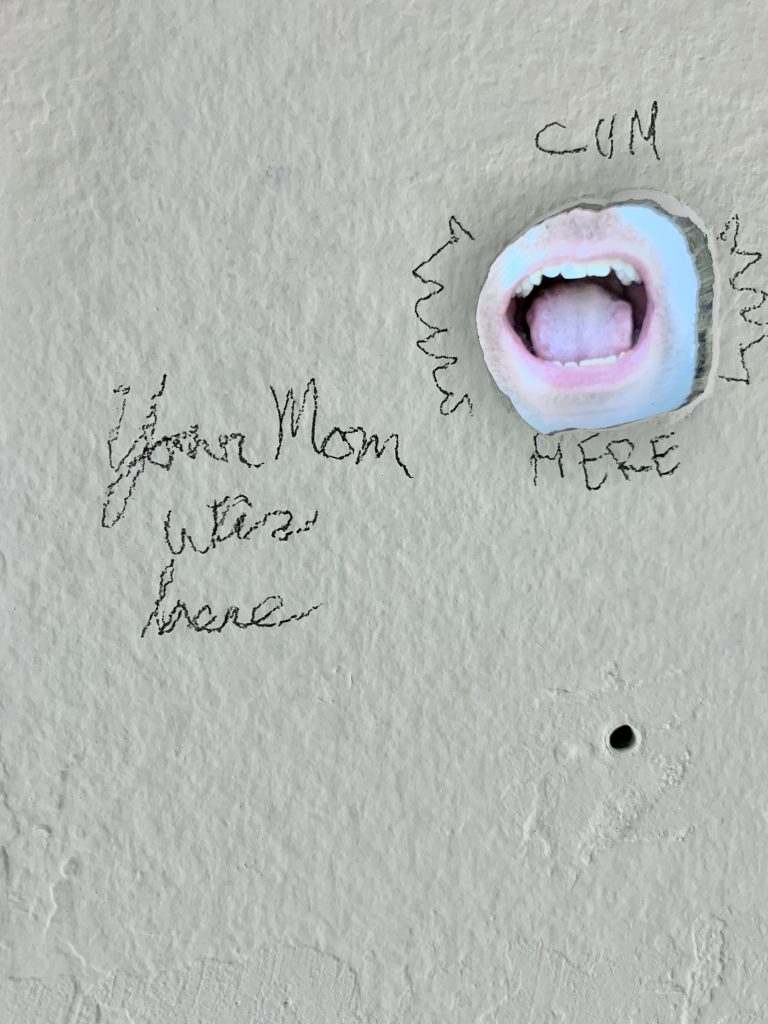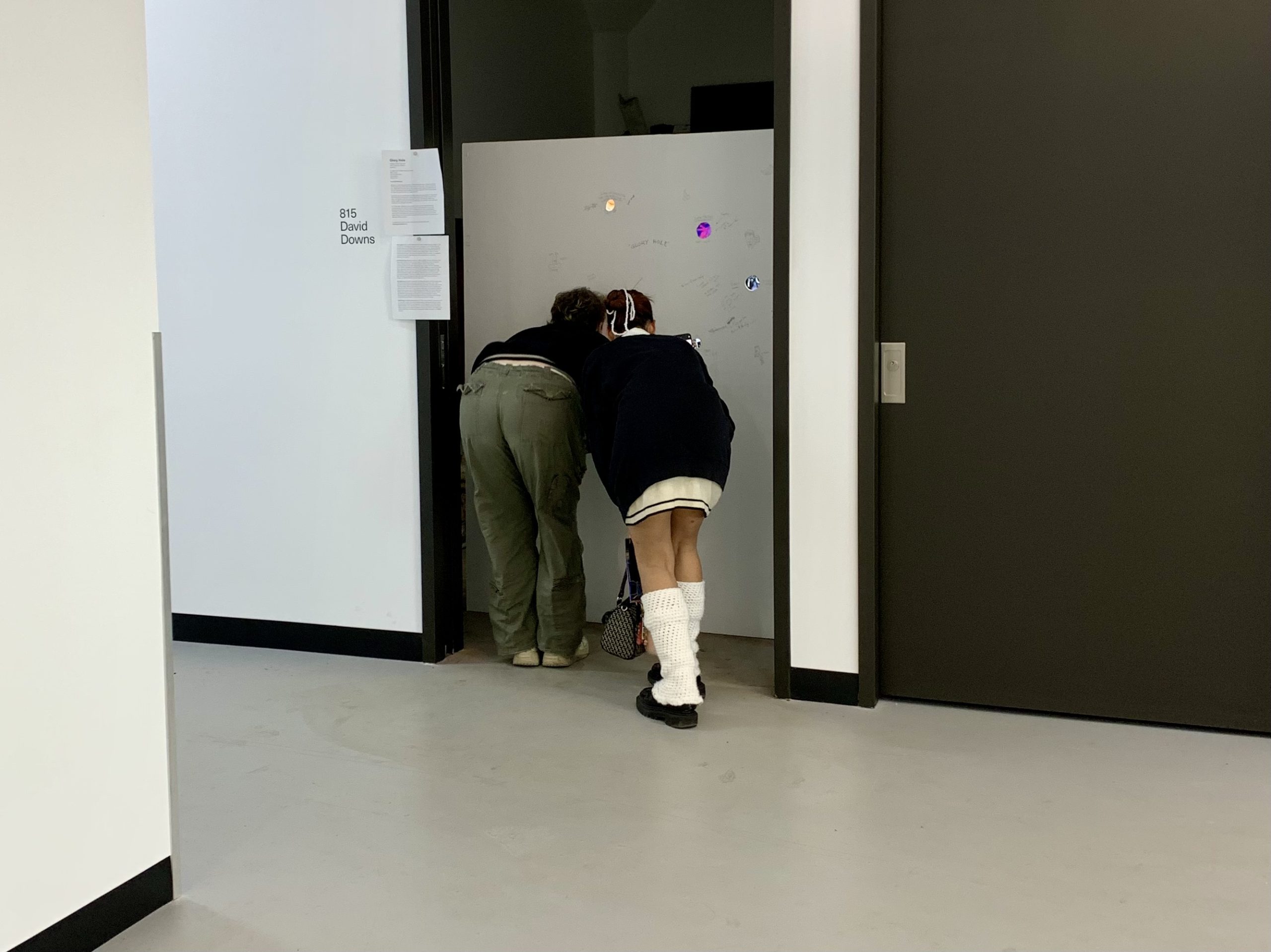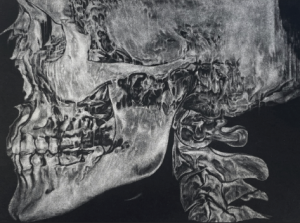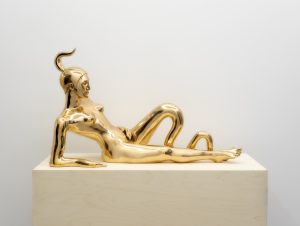It feels fitting to speak about Polonium Projects’ Glory Hole long after its de-installation. It was an embrace of the friction between the mundane and the surprising. That friction is deep-rooted within any conversation on sex, specifically public, specifically queer sex. Viewers might know what a glory hole refers to –– holes found in liminal public spaces, the zones that tread the line between public and private, usually bathroom stalls.
“Queerness is not yet here”, states José Esteban Muñoz in the opening lines of the essay collection, Cruising Utopia. In the collection, now a standard in the field of Queer Theory, Esteban Muñoz positions queerness as a potentially utopian project, a way of being that can exist outside the organizing structures of capitalism: the nuclear family, private property, and transactional love. Now, this is not to assert that all human emotion is held in sway by the market (some aspects of life are just too wonderfully unruly) but in a capitalist system that depends upon white supremacist ideology and carceral logic, heterosexual reproduction is called upon to create more workers. Life itself then becomes something to be parceled out and given in increments to a boss, a place to maximize linear growth and potential. However, the strictures of heterosexuality within capitalism do not hold for Esteban Muñoz’s conception of queerness, for queerness then becomes the social alterity: it serves no means of production, it cares nothing for the imaginaries of whiteness, and can be a source of freedom for those previously denied.
We can locate similar ways of being in novelist and critical theorist Sam Delany’s Time Square Red, Time Square Blue. Time Square details Delany’s experiences within the pornographic theaters of late twentieth-century New York. Delany details not just his sexual liaisons with the other theater patrons but the friendships and relationships he formed with these men. Delany situates these liminal spaces, darkened theaters filled with sex public and private, as communities filled with care, friendships, and commitment. These theaters were places where folx could finally be free to be themselves.
Termite art, coined by Manny Farber, is an art style that eats at its own pre-inscribed boundaries. Termite art challenges the very notion of artistic boundaries, as limitations are acknowledged only to be torn apart, creating new ways of viewing, experiencing, hearing, and touching a work untrammeled by control. Glory Hole is a show that challenges what an art exhibition can be through the scale of the work shown and its playful, challenging relationship to the gaze of the viewer. Featuring work by artists Anna Showers-Cruser, Boris Ostrerov, David Downs, and Rabia Tayyabi, Glory Hole consists of a large wall of plywood, painted white, and covered with small sketches, drawings, and phrases done by previous visitors to the exhibition. Peepholes, the titular “glory holes” dot the wall. The effect is reminiscent of a bathroom stall, the experience of reading graffiti, of seeing the remnants of those who moved in the space before you.

To see the art you must move to each hole and look. In the decision to look, there lives a leap of faith, a chance taken, surprise accepted. Your gaze then becomes a tool of exploration, a way in which to not only experience the art but interrogate your own agency in creating this experience. Art, as Glory Hole keenly realizes, is borne of the ambiguities inherent to relationships. No one lives in a straight line. The nooks, crannies, and corners of life ache to be explored. Glory Hole is a show that asks do you dare jump, do you dare look, do you dare peer beyond the easy, the accepted? Do you dare?
In David Downs’ Alter of Knowledge and the Question of Sexual Morality (2022) and Selfie Hole (2022) sexuality is interrogated, poked, and prodded. The viewer may be taken aback when confronted by the plaster phallic cast covered in gray graphite powder in Alter or the cavern of an open mouth, lips agape, in Selfie Hole. This friction between one’s expectations and the fleshy reality of the work stems from the dissonances of sex in public spaces. More broadly the confrontation of Downs’ art forces viewers to acknowledge the eroticism within public spaces and how that energy is repressed or sublimated towards social ends. While neither piece is larger than an iPhone, they work in tandem to recreate the mechanics of a functional glory hole: lips move and a penis waits to be received just beyond the wall.

While the human figure is absent in Anna Showers-Cruser’s Moss Hole (2022), the specter of the erotic remains. Sensuality dominates the intimate terrain, textures, and color overtake the eye when you peer into the artist’s viewing hole. Though the human form isn’t the subject of the work, the artist highlights its overwhelming presence through repurposed PHQ-9 assessment forms (the diagnostic intake forms for a depression diagnosis) and moss that undulates in waves across the interior of the hole. Calling these materials, “materia medica”, Latin for pharmacy of the body, the body is rendered as something penetrable, ever-present, a force that can move the world and be moved in return. Showers-Cruser describes the piece “as a femme ode to queer pleasure activism” crediting activists adrienne maree brown and Keith Cylar for the phrase. The body becomes a psychedelic landscape with every twist and whirl of material: it is a home to heal, a home to pleasures both hidden and unexpected, a home filled with care.
Rabia Tayyabi’s vibrant colors in their animation Glory Hole (2022) speak to the same pleasures, these are the pleasures of the senses. Surprise and decadence deeply felt. Through the hole, viewers witness the combination of movement, light, and color to form images of experiences bereft of words, of experience that leaves the body open and expectant. Boris Ostrerov’s dripping wet interiors Untitled (2021) speak to these same sensations, color, and shape, the human form rendered again, again, and again. Aren’t we our most human at our most vulnerable, most pliable, and penetrable, blood whirling through our eardrums?

When you think of Glory Hole think about how you move through the world with others. Think about how the world moves through you. Where does surprise live? Where does sex, the erotic find home? Is it within you? Think hard on these questions, think about what you hide and what you force deep within yourself. What’s struggling to speak, where do you want to look? Go ahead, take a look, see what awaits on the other side of the hole.

About the Author: Annette LePique is a Lacanian.






